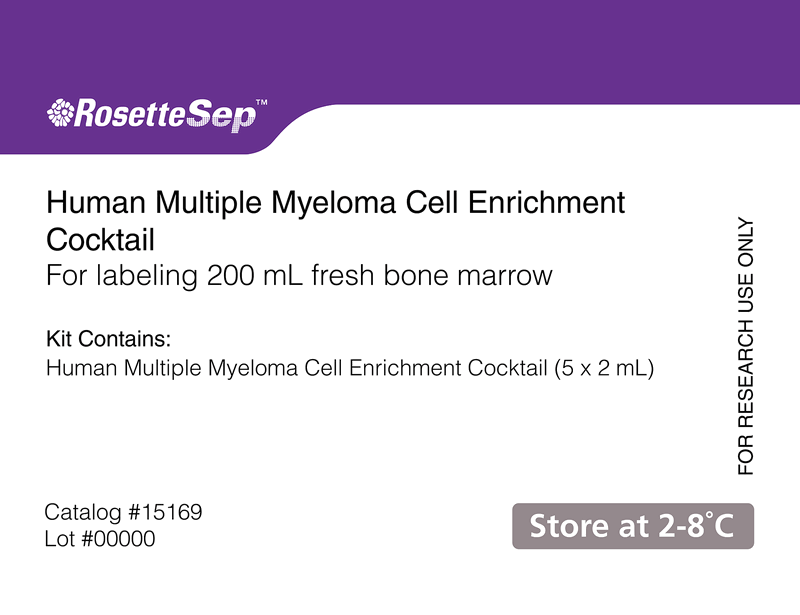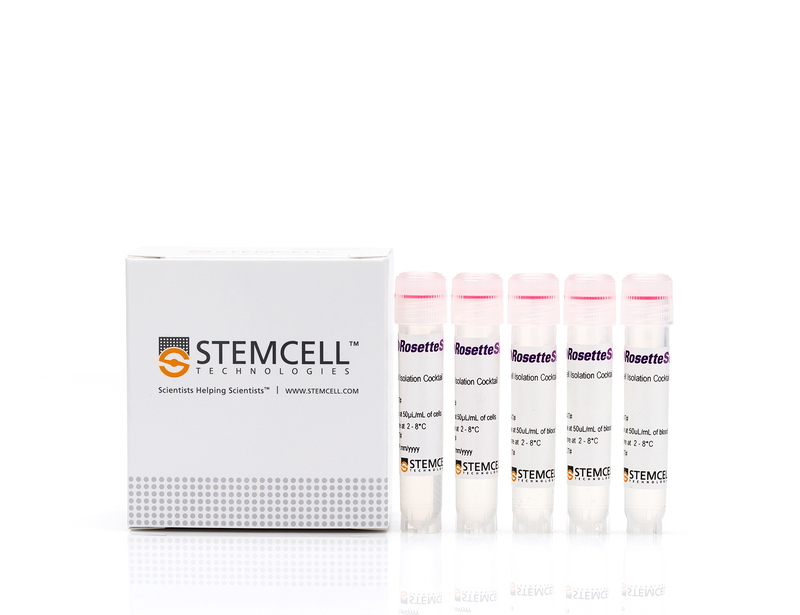RosetteSep™ Human Multiple Myeloma Cell Enrichment Cocktail
Immunodensity negative selection cocktail
概要
The RosetteSep™ Human Multiple Myeloma Cell Enrichment Cocktail is designed to enrich multiple myeloma cells (B cell and plasma cells) from fresh bone marrow aspirates by negative selection. Unwanted cells are targeted for removal with Tetrameric Antibody Complexes recognizing CD2, CD14, CD33, CD41, CD45RA, CD66b and glycophorin A on red blood cells (RBCs). When centrifuged over a buoyant density medium such as Lymphoprep™ (Catalog #07801), the unwanted cells pellet along with the RBCs. The purified multiple myeloma cells are present as a highly enriched population at the interface between the plasma and the buoyant density medium.
Advantages
• Fast and easy-to-use
• Requires no special equipment or training
• Untouched, viable cells
• Requires no special equipment or training
• Untouched, viable cells
Components
- RosetteSep™ Human Multiple Myeloma Cell Enrichment Cocktail (Catalog #15129)
- RosetteSep™ Human Multiple Myeloma Cell Enrichment Cocktail, 2 mL
- RosetteSep™ Human Multiple Myeloma Cell Enrichment Cocktail (Catalog #15169)
- RosetteSep™ Human Multiple Myeloma Cell Enrichment Cocktail, 5 x 2 mL
Subtype
Cell Isolation Kits
Cell Type
B Cells, Plasma
Species
Human
Sample Source
Bone Marrow
Selection Method
Negative
Application
Cell Isolation
Brand
RosetteSep
Area of Interest
Cancer Research, Immunology
技术资料
| Document Type | 产品名称 | Catalog # | Lot # | 语言 |
|---|---|---|---|---|
| Product Information Sheet | RosetteSep™ Human Multiple Myeloma Cell Enrichment Cocktail | 15129, 15169 | All | English |
| Safety Data Sheet | RosetteSep™ Human Multiple Myeloma Cell Enrichment Cocktail | 15129 | All | English |
数据及文献
Publications (10)
Blood 2017 JAN
p53-related protein kinase confers poor prognosis and represents a novel therapeutic target in multiple myeloma.
Abstract
Abstract
p53-related protein kinase (TP53RK, also known as PRPK) is an upstream kinase which phosphorylates (Ser15) and mediates p53 activity. Here we show that TP53RK confers poor prognosis in MM patients; and conversely, that TP53RK knockdown inhibits p53 phosphorylation and triggers multiple myeloma (MM) cell apoptosis, associated with downregulation of c-Myc and E2F-1-mediated upregulation of pro-apoptotic Bim. We further demonstrate that TP53RK downregulation also triggers growth inhibition in p53-deficient (KMS-11) and p53-mutant (U266) MM cell lines, and identify novel downstream targets of TP53RK including ribonucleotide reductase-1, telomerase reverse transcriptase, and cyclin dependent kinase inhibitor 2C (CDKN2C). Our previous studies showed that immunomodulatory drugs (IMiDs) downregulate p21 and trigger apoptosis in wt-p53 MM.1S cells, Importantly we here demonstrate by pull-down, nuclear magnetic resonance spectroscopy, differential scanning fluorimetry, and isothermal titration calorimetry, that IMiDs bind and inhibit TP53RK, with biologic sequelae similar to TP53RK knockdown. Our studies therefore demonstrate that either genetic or pharmacological inhibition of TP53RK triggers MM cell apoptosis via both p53-Myc axis-dependent and -independent pathways, validating TP53RK as a novel therapeutic target in patients with poor prognosis MM.
Proceedings of the National Academy of Sciences of the United States of America 2016 OCT
Discovery of selective small-molecule HDAC6 inhibitor for overcoming proteasome inhibitor resistance in multiple myeloma.
Abstract
Abstract
Multiple myeloma (MM) has proven clinically susceptible to modulation of pathways of protein homeostasis. Blockade of proteasomal degradation of polyubiquitinated misfolded proteins by the proteasome inhibitor bortezomib (BTZ) achieves responses and prolongs survival in MM, but long-term treatment with BTZ leads to drug-resistant relapse in most patients. In a proof-of-concept study, we previously demonstrated that blocking aggresomal breakdown of polyubiquitinated misfolded proteins with the histone deacetylase 6 (HDAC6) inhibitor tubacin enhances BTZ-induced cytotoxicity in MM cells in vitro. However, these foundational studies were limited by the pharmacologic liabilities of tubacin as a chemical probe with only in vitro utility. Emerging from a focused library synthesis, a potent, selective, and bioavailable HDAC6 inhibitor, WT161, was created to study the mechanism of action of HDAC6 inhibition in MM alone and in combination with BTZ. WT161 in combination with BTZ triggers significant accumulation of polyubiquitinated proteins and cell stress, followed by caspase activation and apoptosis. More importantly, this combination treatment was effective in BTZ-resistant cells and in the presence of bone marrow stromal cells, which have been shown to mediate MM cell drug resistance. The activity of WT161 was confirmed in our human MM cell xenograft mouse model and established the framework for clinical trials of the combination treatment to improve patient outcomes in MM.
Scientific reports 2016
Immuno-targeting the multifunctional CD38 using nanobody.
Abstract
Abstract
CD38, as a cell surface antigen is highly expressed in several hematologic malignancies including multiple myeloma (MM) and has been proven to be a good target for immunotherapy of the disease. CD38 is also a signaling enzyme responsible for the metabolism of two novel calcium messenger molecules. To be able to target this multifunctional protein, we generated a series of nanobodies against CD38 with high affinities. Crystal structures of the complexes of CD38 with the nanobodies were solved, identifying three separate epitopes on the carboxyl domain. Chromobodies, engineered by tagging the nanobody with fluorescence proteins, provide fast, simple and versatile tools for quantifying CD38 expression. Results confirmed that CD38 was highly expressed in malignant MM cells compared with normal white blood cells. The immunotoxin constructed by splicing the nanobody with a bacterial toxin, PE38 shows highly selective cytotoxicity against patient-derived MM cells as well as the cell lines, with half maximal effective concentration reaching as low as 10(-11) molar. The effectiveness of the immunotoxin can be further increased by stimulating CD38 expression using retinoid acid. These results set the stage for the development of clinical therapeutics as well as diagnostic screening for myeloma.
Blood 2010 MAY
GCS-100, a novel galectin-3 antagonist, modulates MCL-1, NOXA, and cell cycle to induce myeloma cell death.
Abstract
Abstract
GCS-100 is a galectin-3 antagonist with an acceptable human safety profile that has been demonstrated to have an antimyeloma effect in the context of bortezomib resistance. In the present study, the mechanisms of action of GCS-100 are elucidated in myeloma cell lines and primary tumor cells. GCS-100 induced inhibition of proliferation, accumulation of cells in sub-G(1) and G(1) phases, and apoptosis with activation of both caspase-8 and -9 pathways. Dose- and time-dependent decreases in MCL-1 and BCL-X(L) levels also occurred, accompanied by a rapid induction of NOXA protein, whereas BCL-2, BAX, BAK, BIM, BAD, BID, and PUMA remained unchanged. The cell-cycle inhibitor p21(Cip1) was up-regulated by GCS-100, whereas the procycling proteins CYCLIN E2, CYCLIN D2, and CDK6 were all reduced. Reduction in signal transduction was associated with lower levels of activated IkappaBalpha, IkappaB kinase, and AKT as well as lack of IkappaBalpha and AKT activation after appropriate cytokine stimulation (insulin-like growth factor-1, tumor necrosis factor-alpha). Primary myeloma cells showed a direct reduction in proliferation and viability. These data demonstrate that the novel therapeutic molecule, GCS-100, is a potent modifier of myeloma cell biology targeting apoptosis, cell cycle, and intracellular signaling and has potential for myeloma therapy.
European journal of haematology 2010 MAR
Bortezomib restores stroma-mediated APO2L/TRAIL apoptosis resistance in multiple myeloma.
Abstract
Abstract
OBJECTIVES: Hematopoietic stroma promotes resistance to immune control by APO2L/TRAIL in multiple myeloma (MM) cells in part by increasing synthesis of the anti-apoptotic protein c-FLIP. Here, we tested whether bortezomib can reverse the APO2L/TRAIL environmental mediated-immune resistance (EM-IR). MATERIAL AND METHODS: MM cell lines (RPMI 8226 and U266) and CD138+ patient's MM cells were directly adhered to HS5 stroma exposed to HS5 or bone marrow stroma of patients with MM released soluble factors in a transwell system. Cells were treated with either APO2L/TRAIL (10 ng/mL), bortezomib (10 nm) or both. RESULTS: Pretreatment with bortezomib effectively overcomes APO2L/TRAIL apoptosis resistance in myeloma cell lines and in CD138+ cells while directly adhered or in transwell assay. Bortezomib was not cytotoxic to HS5 stroma cells and only altered monocyte chemotactic protein-2-3 and IL-10 levels in the stroma-myeloma milieu. Factors released by HS5 stroma increased expression of c-FLIP, induced STAT-3 and ERK phosphorylation and reduced DR4 receptor expression in MM cells. HS5 stroma-released factor(s) induced NF-kappaB activation after 20 h exposure in association with an enhanced c-FLIP transcription. Bortezomib effectively reduced c-FLIP protein expression without affecting other proteins. Bortezomib also increased DR4 and DR5 expression in the presence of stroma. CONCLUSIONS: These findings provide the rationale to combine bortezomib and APO2L/TRAIL to disrupt the influence of the stroma microenvironment on MM cells.
Blood 2006 MAY
Perifosine, an oral bioactive novel alkylphospholipid, inhibits Akt and induces in vitro and in vivo cytotoxicity in human multiple myeloma cells.
Abstract
Abstract
Perifosine is a synthetic novel alkylphospholipid, a new class of antitumor agents which targets cell membranes and inhibits Akt activation. Here we show that baseline phosphorylation of Akt in multiple myeloma (MM) cells is completely inhibited by perifosine [octadecyl-(1,1-dimethyl-piperidinio-4-yl)-phosphate] in a time- and dose-dependent fashion, without inhibiting phosphoinositide-dependent protein kinase 1 phosphorylation. Perifosine induces significant cytotoxicity in both MM cell lines and patient MM cells resistant to conventional therapeutic agents. Perifosine does not induce cytotoxicity in peripheral blood mononuclear cells. Neither exogenous interleukin-6 (IL-6) nor insulinlike growth factor 1 (IGF-1) overcomes Perifosine-induced cytotoxicity. Importantly, Perifosine induces apoptosis even of MM cells adherent to bone marrow stromal cells. Perifosine triggers c-Jun N-terminal kinase (JNK) activation, followed by caspase-8/9 and poly (ADP)-ribose polymerase cleavage. Inhibition of JNK abrogates perifosine-induced cytotoxicity, suggesting that JNK plays an essential role in perifosine-induced apoptosis. Interestingly, phosphorylation of extracellular signal-related kinase (ERK) is increased by perifosine; conversely, MEK inhibitor synergistically enhances Perifosine-induced cytotoxicity in MM cells. Furthermore, perifosine augments dexamethasone, doxorubicin, melphalan, and bortezomib-induced MM cell cytotoxicity. Finally, perifosine demonstrates significant antitumor activity in a human plasmacytoma mouse model, associated with down-regulation of Akt phosphorylation in tumor cells. Taken together, our data provide the rationale for clinical trials of perifosine to improve patient outcome in MM.




